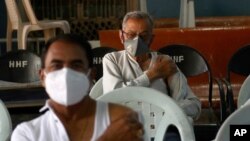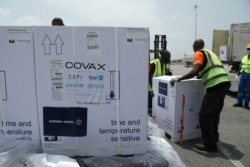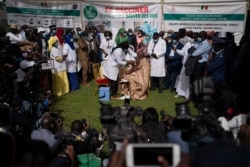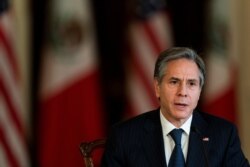U.S. President Joe Biden and the prime ministers of Japan, India, and Australia met virtually Friday for a summit of the Quadrilateral Security Dialogue, where they discussed strategies to counter China’s rising influence in the Indo-Pacific region, including an offer to match Beijing’s ambitious vaccine diplomacy.
“We all have to focus on generating domestic demand and driving sustainable global growth,” Biden said during the summit. “And with launching an ambitious new joint partnership that is going to boost vaccine manufacturing for the global benefit and strengthen vaccinations, to benefit the entire Indo-Pacific."
The administration said the Quad has launched a financing mechanism to massively ramp up vaccine production in the region.
“The Quad committed to delivering up to one billion doses to ASEAN (Association of Southeast Asian Nations), the Indo-Pacific and beyond by the end of 2022,” National Security Advisor Jake Sullivan said Friday.
The group has put together “complex financing vehicles” to dramatically increase vaccine production capacity, a Biden administration official said in a briefing call to reporters Thursday. Another official said the U.S. International Development Finance Corporation is working with companies in India and the governments of Japan and Australia to increase production of vaccines already authorized by the World Health Organization.
Quad partners will ensure expanded manufacturing will be exported for global benefit, to be procured through key multilateral initiatives, such as COVAX, the White House said in a statement.
COVAX is the global mechanism to distribute 2 billion doses of vaccines to 94 lower- and middle-income countries by the end of the year, partly by using AstraZeneca/Oxford University-developed vaccines manufactured by the Serum Institute of India.
Biden has been under pressure to respond to Beijing’s vaccine diplomacy as he seeks to vaccinate all Americans first by ensuring that the U.S. vaccine stockpile is “over supplied,” to prepare to vaccinate against new variants, and to vaccinate children. There is currently not enough data to determine which of the three vaccines authorized for emergency use in the U.S. is safe and effective for children.
Chinese President Xi Jinping proclaimed in May that Chinese-made vaccines would become a “global public good”. Since then, Beijing has pledged roughly half a billion doses of its vaccine to more than 45 countries, according to a country-by-country Associated Press tally. After China's initial failures in handling the outbreak, some see Beijing’s vaccine diplomacy as a face-saving tactic and a means to expand its influence.
The Biden administration aims to counter Beijing’s narrative as it seeks to address the needs for vaccinations at home and around the world, said Sheila Smith, a senior fellow at the Council on Foreign Relations.
“They want a coalition approach to bring all those pieces of the COVID response together to make sure that we're not just thinking about ourselves, the rich countries of the region, but we're also thinking about countries that don't have the resources and providing an alternative to the Chinese approach,” Smith said.
Countering China
The Quad is not a formal military alliance but often seen as a counterweight to growing Chinese military and economic influence in Asia. The 90-minute Friday meeting would be the first leaders’ summit since the Quad’s first meeting in 2004 following the tsunami in Aceh, Indonesia.
“The four leaders did discuss the challenge posed by China, and they made clear that none of them have any illusions about China, but today was not fundamentally about China,” Sullivan said.
Analysts say there is wide expectation that the summit will elevate the Biden administration's agenda in the Indo-Pacific.
“This is a pretty big signal that this is a high priority for the new administration,” said Smith.
Following the Quad summit, Secretary of State Antony Blinken and Defense Secretary Lloyd Austin will travel together to Japan and South Korea, followed by a solo trip by Austin to India.
Without providing details on the timing, the administration also announced that Japanese Prime Minister Yoshihide Suga will be the first leader to visit Biden at the White House in person.
The U.S. wants to return to strong U.S. alliances in the region to project strength to China, according to Bonnie Glaser, director of China Power Project at the Center for Strategic and International Studies.
“The Biden administration has crafted this arrangement to signal that it is engaging from a position of strength," she said.
State Department spokesperson Ned Price acknowledged Thursday that over the course of recent years these alliances “in some cases have atrophied, in some cases, they have frayed."
In November 2017, former President Donald Trump in Vietnam outlined the U.S. vision for a “free and open Indo-Pacific.”
While the Trump administration’s strategy in the region focused largely on maritime security and trade, the Biden administration is seeking a more comprehensive approach, including cooperation to defeat COVID-19, combat climate change, ensure a resilient supply chain and post-pandemic economic recovery.
“It’s a whole – how does the region look going forward, and how do we maintain the prosperity that has long been part of the Indo-Pacific?” Smith said.
After the series of meetings with regional allies, Blinken and national security adviser Jake Sullivan will meet their Chinese counterparts in Anchorage, Alaska, on March 18.
VOA Mandarin contributed to this report.













